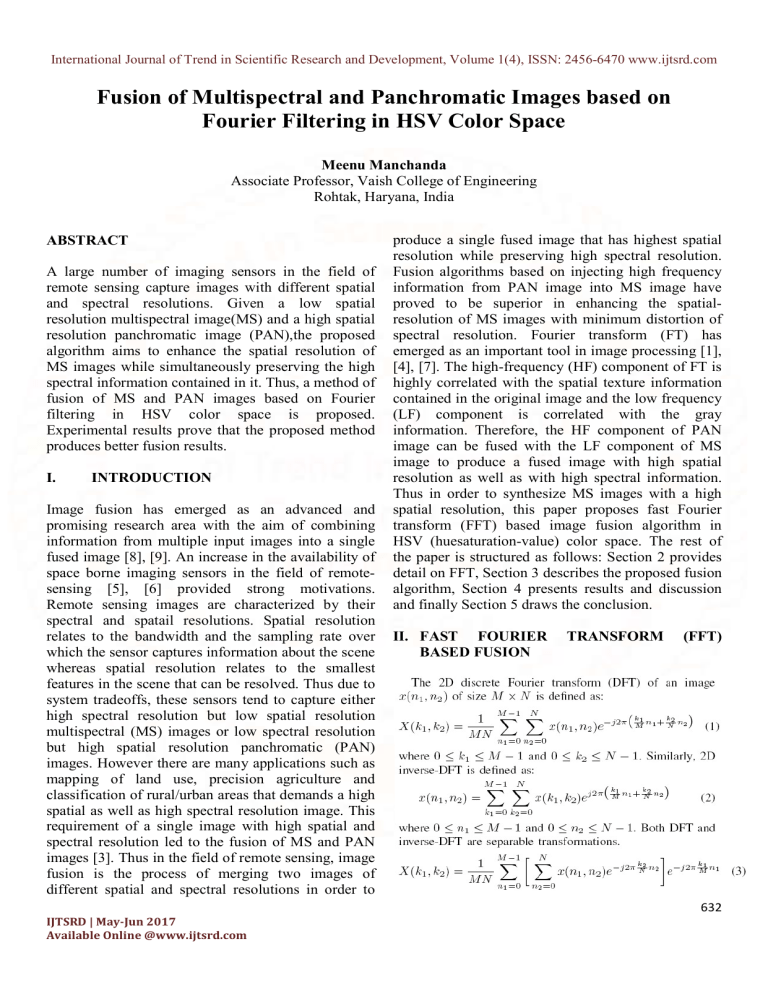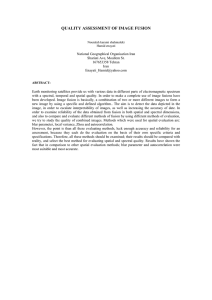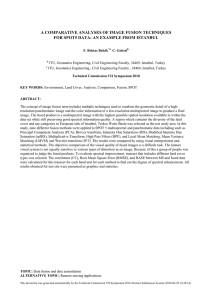
International Journal of Trend in Scientific Research and Development, Volume 1(4), ISSN: 2456-6470 www.ijtsrd.com
Fusion of Multispectral and Panchromatic Images based on
Fourier Filtering in HSV Color Space
Meenu Manchanda
Associate Professor, Vaish College of Engineering
Rohtak, Haryana, India
ABSTRACT
A large number of imaging sensors in the field of
remote sensing capture images with different spatial
and spectral resolutions. Given a low spatial
resolution multispectral image(MS) and a high spatial
resolution panchromatic image (PAN),the proposed
algorithm aims to enhance the spatial resolution of
MS images while simultaneously preserving the high
spectral information contained in it. Thus, a method of
fusion of MS and PAN images based on Fourier
filtering in HSV color space is proposed.
Experimental results prove that the proposed method
produces better fusion results.
I.
INTRODUCTION
Image fusion has emerged as an advanced and
promising research area with the aim of combining
information from multiple input images into a single
fused image [8], [9]. An increase in the availability of
space borne imaging sensors in the field of remotesensing [5], [6] provided strong motivations.
Remote sensing images are characterized by their
spectral and spatail resolutions. Spatial resolution
relates to the bandwidth and the sampling rate over
which the sensor captures information about the scene
whereas spatial resolution relates to the smallest
features in the scene that can be resolved. Thus due to
system tradeoffs, these sensors tend to capture either
high spectral resolution but low spatial resolution
multispectral (MS) images or low spectral resolution
but high spatial resolution panchromatic (PAN)
images. However there are many applications such as
mapping of land use, precision agriculture and
classification of rural/urban areas that demands a high
spatial as well as high spectral resolution image. This
requirement of a single image with high spatial and
spectral resolution led to the fusion of MS and PAN
images [3]. Thus in the field of remote sensing, image
fusion is the process of merging two images of
different spatial and spectral resolutions in order to
produce a single fused image that has highest spatial
resolution while preserving high spectral resolution.
Fusion algorithms based on injecting high frequency
information from PAN image into MS image have
proved to be superior in enhancing the spatialresolution of MS images with minimum distortion of
spectral resolution. Fourier transform (FT) has
emerged as an important tool in image processing [1],
[4], [7]. The high-frequency (HF) component of FT is
highly correlated with the spatial texture information
contained in the original image and the low frequency
(LF) component is correlated with the gray
information. Therefore, the HF component of PAN
image can be fused with the LF component of MS
image to produce a fused image with high spatial
resolution as well as with high spectral information.
Thus in order to synthesize MS images with a high
spatial resolution, this paper proposes fast Fourier
transform (FFT) based image fusion algorithm in
HSV (huesaturation-value) color space. The rest of
the paper is structured as follows: Section 2 provides
detail on FFT, Section 3 describes the proposed fusion
algorithm, Section 4 presents results and discussion
and finally Section 5 draws the conclusion.
II. FAST FOURIER
BASED FUSION
TRANSFORM
(FFT)
632
IJTSRD | May-Jun 2017
Available Online @www.ijtsrd.com
International Journal of Trend in Scientific Research and Development, Volume 1(4), ISSN: 2456-6470 www.ijtsrd.com
Fast Fourier transform (FFT) is an efficient way to
compute DFT. It exploits two important properties,
symmetry and periodicity, of the phase factor i.e.
to compute DFT.
Fig 1: Block diagram showing FFT based image
fusion
Fig 2: FFT- HSV based fusion
III.
PROPOSED WORK
The main aim of the proposed work is to fuse two
images, a PAN image and a MS image that have been
captured at different spatial resolution to produce a
single image that contains spatial information of high
spatial resolution image i.e. PAN image and spectral
information of low spatial resolution image i.e. MS
image. The proposed work is illustrated in Fig.1 and
is described as follows:
1) Input MS and PAN images are first converted from
RGB (red-green-blue) color space to HSV (huesaturationvalue) color space.
2) The PAN image and the V-channel information of
the MS image are transformed into frequency domain
using 2D-FFT.
3) The fast Fourier transformed V-channel
information of MS image is then passed through an
appropriate LPF whereas the fast Fourier transformed
PAN image is
passed through an appropriate HPF.
4) The low-pass filtered information is then added to
the high-pass filtered information.
5) The sum information is transformed back into the
spatial domain using 2D-IFFT to produce V-channel
information i.e. Vfused of the fused image.
6) The fused V-channel information along with the
color information (i.e. H and S) of the multispectral
image is finally converted from HSV color space to
RGB color space to produce spatially enhanced MS
image.
IV.
RESULTS AND DISCUSSIONS
The proposed method is experimented on different
sets of MS and PAN images of size 256256. MS
images with low spatial resolution but high spectral
resolution are shown in Fig.2 (a) - Fig. 4(a) and PAN
images with high spatial resolution but low spectral
resolution is shown in Fig. 2(b) - Fig. 4(b)
respectively. The fused images obtained using the
proposed method is shown in Fig. 2(d) - Fig. 4(d)
respectively. The fused images obtained using FFT
based fusion method is also shown in Fig. 2(c) - Fig.
4(c) respectively. From these fused images it is
observed that the proposed method produces the fused
images with improved spatial resolution and well
preserved spectral information in comparison to the
FFT based fusion method. This is because fusion in
RGB color space does not utilize the correlation
between different image channels [2] and generates
undesirable visual effects in the fusion results whereas
HSV color is much closer to humans’ perception to
Color and therefore fusion in HSV color space yields
better fusion results.
633
IJTSRD | May-Jun 2017
Available Online @www.ijtsrd.com
International Journal of Trend in Scientific Research and Development, Volume 1(4), ISSN: 2456-6470 www.ijtsrd.com
REFERENCES
[1] M Ehlers and D Tomowski. On segment based
image fusion. Object-Based Image Analysis, pages
735–754, 2008.
[2] L. Georgieva, T. Dimitrova, and N. Angelov. Rgb
and hsv colour models in colour identification of
digital traumas images. Citeseer.
[3] L. Hu, B. Xiangli, L. Su, and Y. Yuan. Fusion of
multispectral and panchromatic images using lab
transform based on fourier filtering. In 2012 IEEE
International Geoscience and Remote Sensing
Symposium,pages 2284–2287, July 2012.
[4] VPS Naidu. Multi-resolution image fusion by fft.
In Image Information Processing (ICIIP), 2011
International Conference on, pages 1–6. IEEE,2011.
[5] F. Nencini, A. Garzelli, S. Baronti, and L.
Alparone. Remote sensing image fusion using the
curvelet transform. Information Fusion, 8(2):143–156,
2007.
Fig 3: Fusion of MS/PAN (Set 1) images
[6] C. Pohl and J. L. Van Genderen. Review article
multisensor image fusion in remote sensing: concepts,
methods and applications. International journal of
remote sensing, 19(5):823– 854, 1998.
[7] Ante Poljicak, Lidija Mandic, and Darko Agic.
Discrete fourier transform–based watermarking
method with an optimal implementation radius.
Journal of Electronic Imaging, 20(3):033008–033008,
2011.
[8] Tania Stathaki. Image fusion: algorithms and
applications. Academic Press, 2011.
[9] B. Yang, Z. L Jing, and H. T. Zhao. Review of
pixel-level image fusion. Journal of Shanghai
Jiaotong University (Science), 15(1):6–12, 2010.
Fig 4: Fusion of MS/PAN (Set 2) images
634
IJTSRD | May-Jun 2017
Available Online @www.ijtsrd.com
International Journal of Trend in Scientific Research and Development, Volume 1(4), ISSN: 2456-6470 www.ijtsrd.com
Fig 5: Fusion of MS/PAN (Set 3) images
635
IJTSRD | May-Jun 2017
Available Online @www.ijtsrd.com





